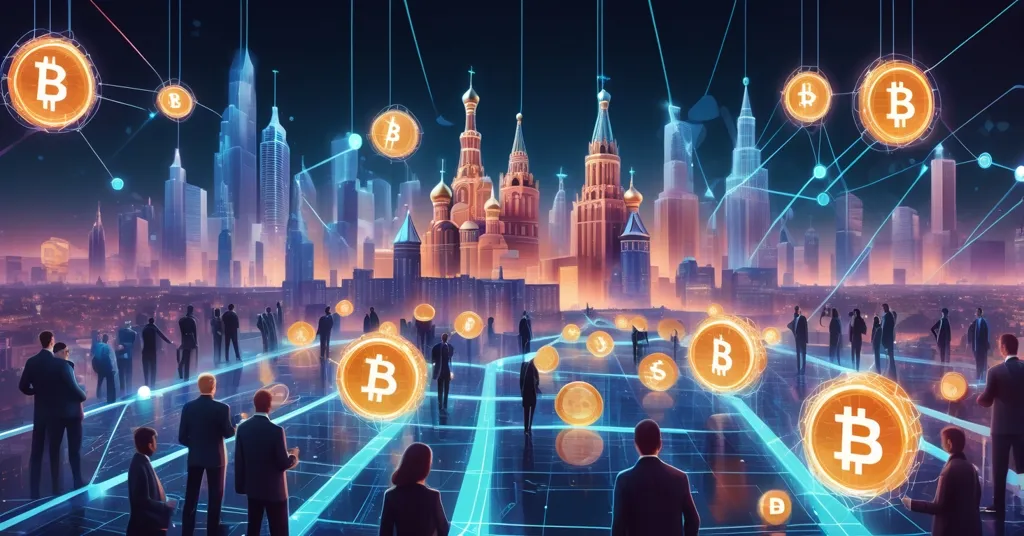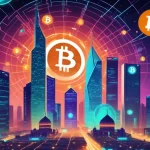Russia’s Central Bank Uses Blockchain Tokenization to Attract Foreign Investors

Russia’s Central Bank Bets on Blockchain Tokenization to Lure Foreign Investors to Domestic Shares
Russia’s Central Bank is rolling the dice on a cutting-edge strategy: using blockchain-based tokenization to let foreign investors snap up shares in domestic companies, effectively dodging the chokehold of international sanctions. This audacious plan could redefine how Russia navigates financial isolation while leveraging decentralized tech to crack open new markets.
- Tokenization Push: Blockchain tech to enable foreign investment in Russian shares.
- Sanctions Dodge: A clever bypass of restricted financial systems.
- Target Markets: Focus on BRICS nations and friendly regions like the UAE.
What Is Tokenization and Why Now?
Let’s break it down. Tokenization is the process of converting ownership of real-world assets (RWAs)—think company shares, real estate, or even a Picasso—into digital tokens on a blockchain. These tokens act like digital deeds, representing a stake in the underlying asset, and can be traded securely without the usual middlemen like banks or brokers. Imagine buying a tiny slice of a rental property halfway across the world; instead of paperwork, you get a digital token that proves your ownership, tradable with a click. For Russia, this isn’t just tech for tech’s sake—it’s a lifeline. With sanctions tightening since 2014 and hitting a fever pitch post-2022 due to geopolitical conflicts, traditional financial infrastructure like payment networks and banks are often off-limits for cross-border deals. Tokenization offers a workaround, operating outside these sanctioned systems.
The idea isn’t entirely new for Russia. The country has had a rocky relationship with crypto, swinging from outright bans to cautious adoption for state purposes over the past decade. Now, under pressure, the Central Bank sees blockchain as a strategic tool. First Deputy Chairman Vladimir Chistyukhin has been vocal about the plan, highlighting the critical role of international collaboration. “In this area, foreign partners will be playing a significant role. I am talking about the foreign entities who are willing to tokenize Russian assets in order to buy and sell them abroad,” he told RBC, a major Russian media outlet. The tech isn’t just about bypassing barriers—it’s about positioning Russia as a player in the burgeoning digital asset space, as detailed in a recent report on Russia’s Central Bank tokenization efforts.
Geopolitical Chess: Targeting BRICS and Beyond
Russia isn’t casting a wide net with this initiative. The focus is razor-sharp on specific regions: BRICS countries (Brazil, Russia, India, China, South Africa) and so-called “friendly jurisdictions” like the UAE, Kazakhstan, and Armenia. These nations, less likely to align with Western sanction regimes, represent a deliberate pivot away from traditional financial hubs. A Sovcombank official underscored this strategy, noting that tokenization “could become a suitable tool for investors” from these areas, while also fast-tracking Russia’s integration into the global digital financial system. It’s a calculated move—build economic bridges with allies while tapping into the growing appetite for blockchain-based investments.
This isn’t just about money; it’s 4D chess on a geopolitical board. Russia’s been cut off from much of the Western financial playground, so it’s forging alternative alliances. Blockchain for sanctions bypass isn’t merely a tech play—it’s a statement. Sergei Shvetsov, head of the Moscow Exchange’s Supervisory Board, reinforced this late last month, pointing out that tokenization sidesteps “sanctioned infrastructure.” By ditching legacy systems and intermediaries tangled in restrictions, Russia aims to reconnect with overseas capital. But don’t be fooled into thinking this is pure innovation; it’s survival with a side of defiance.
The Promise of Fractional Ownership
One of the most tantalizing aspects of this tech is fractional ownership—breaking down high-value assets into smaller, affordable chunks. Picture a small retail investor in Dubai or Bangalore, unable to shell out thousands for a full share in a Russian tech giant. With tokenization, they could own a sliver of that pie for a fraction of the cost. Alexey Korolenko, Executive Director of Cifra Markets, sees this as a game-changer. “The real-world assets sector is now in high demand among investors,” he said, adding that tokenizing Russian shares is “entirely feasible.” It’s a democratizing force, lowering the entry barrier for folks who’d otherwise be priced out of global markets.
This could be huge for emerging market investors, especially in BRICS nations where capital might be tight but interest in digital assets is soaring. Beyond accessibility, it ties into a broader trend of real-world asset tokenization, where everything from property to fine art gets digitized and traded on blockchains. Russia’s not just hopping on the bandwagon; it’s trying to drive it in a direction that suits its needs. If successful, this could turn a small-time investor in Kazakhstan into a stakeholder in Moscow’s economy—pretty wild when you think about it.
Risks: From Tech Flaws to Sanctions 2.0
Let’s pump the brakes on the hype train. While the potential of blockchain tokenization for Russian shares is exciting, the road ahead is littered with landmines. First, there’s the tech itself. Blockchain is only as good as the systems behind it. If a smart contract—self-executing code that automates transactions on the blockchain—glitches or gets hacked, investors might end up with digital confetti instead of actual shares. Infrastructure reliability is non-negotiable, and Russia’s track record with tech rollouts doesn’t exactly inspire confidence. Then there’s liquidity, or the ease of buying and selling these tokens without waiting forever or taking a massive hit on value due to low market activity. Will there be enough players in this game to keep it moving?
Political risks are the elephant in the room. Russia’s geopolitical antics aren’t winning any popularity contests, and tokenized assets could easily become the next target for Western regulators looking to close loopholes. What happens if new sanctions slap down on blockchain-based trades? Or if “friendly” jurisdictions buckle under international pressure? And let’s play devil’s advocate for a second: could this tech be exploited to obscure illicit capital flows under the guise of decentralization? It’s not hard to imagine tokenized shares becoming a shiny wrapper for dirty money if oversight is lax. The risks aren’t just technical—they’re ethical and global, and anyone cheering this on needs to keep their eyes wide open.
Decentralization or State Control? A Bitcoin Perspective
As champions of decentralization here at Let’s Talk, Bitcoin, we’re torn on this one. On one hand, Russia’s move is a middle finger to centralized financial gatekeepers, echoing Bitcoin’s original vision of borderless, censorship-resistant money. Anything that chips away at the old guard and pushes for financial sovereignty gets a nod from us in the spirit of effective accelerationism. Blockchain as a tool to bypass sanctions? Hell yeah, that’s the kind of disruption we live for.
But let’s not drink the Kool-Aid just yet. Is this really about empowering individuals, or is Russia hijacking blockchain’s ethos to prop up a struggling, state-controlled economy? Bitcoin maximalists like us have to ask: does this initiative align with the ideals of freedom and privacy, or is it just swapping one set of overlords for another? There’s a real chance tokenized Russian assets could be tightly leashed by the Kremlin, with state-approved blockchains or backdoors undermining any true decentralization. And frankly, it’s a bit of a gut punch to see blockchain tech potentially diluting Bitcoin’s dominance as the ultimate store of value—though, ironically, Russia’s play might validate Bitcoin’s core principles of resisting control. We’re rooting for innovation, but we’ll call bullshit if this turns into a centralized charade draped in crypto buzzwords.
What’s Next for Russia and Blockchain?
Speculating on the future of Russia’s tokenization gambit is a bit like reading tea leaves, but let’s give it a shot. If they pull this off—robust tech, willing investors, minimal backlash—it could be a blueprint for other sanctioned nations like Iran or Venezuela to follow. Picture a network of blockchain-based markets linking “rogue” economies, sidestepping Western dominance. That’s the optimistic, decentralized dream. On the flip side, if the tech flops or new sanctions rain down, this could become a cautionary tale of overreach, scaring off investors and stunting blockchain adoption in the region. A middle ground might emerge: limited success with state-heavy oversight, proving blockchain’s utility but not its liberating potential.
The ripple effects could be massive. Will Western regulators crack down on blockchain loopholes, stifling innovation across the board? Or will this push more countries to experiment with digital assets, accelerating the shift to a tokenized world? For the crypto space, Russia’s high-wire act is a test case. It could validate blockchain as a geopolitical tool, for better or worse, and we’ll be watching every step—and misstep—with a critical eye.
Key Takeaways and Questions
- What is tokenization, and how does it work for Russian shares?
Tokenization turns ownership of assets like company shares into digital tokens on a blockchain, tradable without traditional intermediaries. For Russia, it means foreign investors can buy domestic shares outside sanctioned financial systems, opening up restricted markets. - Why is Russia using blockchain to attract foreign investment?
Sanctions have locked Russia out of traditional financial channels, so blockchain offers a workaround to keep capital flowing. It’s a survival tactic amid economic isolation. - Who are the target investors for tokenized Russian assets?
The focus is on BRICS nations—Brazil, Russia, India, China, South Africa—and friendly regions like the UAE, Kazakhstan, and Armenia, where sanctions aren’t a barrier. - What are the benefits of this tokenization initiative?
It enables fractional ownership for smaller investors, could integrate Russia into the digital economy, and bypasses sanctions to access global capital. It’s a potential win for accessibility and innovation. - What are the major risks involved?
Technical failures in blockchain systems, low market liquidity, and political backlash like new sanctions could derail it. Plus, there’s the ethical concern of misuse for illicit funds. - Could other nations adopt a similar blockchain model?
Absolutely—if Russia succeeds, sanctioned countries like Iran or Venezuela might copy the playbook, creating alternative blockchain markets. Failure, though, could spook others away.
Russia’s dive into blockchain tokenization for domestic shares is a bold experiment, blending financial innovation with geopolitical grit. It’s a chance to stick it to centralized systems and push decentralized tech into uncharted territory—something we’re all for. But let’s not pretend the path is paved with gold. Between tech hiccups, political landmines, and the specter of state overreach, this could just as easily crash and burn. We’re cheering for disruption and freedom, but we’re not naive. The tightrope Russia’s walking is shaky at best, and we’ll keep a sharp eye on whether this truly advances the cause of decentralization or just dresses up old power plays in new tech garb.



